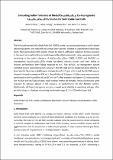Files in this item
Evaluating sulfur-tolerance of metal/Ce0.80Gd0.20O1.90 co-impregnated La0.20Sr0.25Ca0.45TiO3 anodes for solid oxide fuel cells
Item metadata
| dc.contributor.author | Price, Robert | |
| dc.contributor.author | Grolig, Jan G. | |
| dc.contributor.author | Mai, Andreas | |
| dc.contributor.author | Irvine, John T.S. | |
| dc.date.accessioned | 2021-02-12T00:38:59Z | |
| dc.date.available | 2021-02-12T00:38:59Z | |
| dc.date.issued | 2020-04 | |
| dc.identifier | 266485542 | |
| dc.identifier | fc880e44-e12e-428c-af7a-f0331388c3f0 | |
| dc.identifier | 85079091907 | |
| dc.identifier | 000531573600017 | |
| dc.identifier.citation | Price , R , Grolig , J G , Mai , A & Irvine , J T S 2020 , ' Evaluating sulfur-tolerance of metal/Ce 0.80 Gd 0.20 O 1.90 co-impregnated La 0.20 Sr 0.25 Ca 0.45 TiO 3 anodes for solid oxide fuel cells ' , Solid State Ionics , vol. 347 , 115254 . https://doi.org/10.1016/j.ssi.2020.115254 | en |
| dc.identifier.issn | 0167-2738 | |
| dc.identifier.other | ORCID: /0000-0002-8394-3359/work/69463187 | |
| dc.identifier.uri | https://hdl.handle.net/10023/21417 | |
| dc.description | The authors acknowledge funding from the University of St Andrews, HEXIS AG and the EPSRC Grants: EP/M014304/1 “Tailoring of Microstructural Evolution in Impregnated SOFC Electrodes” and EP/L017008/1 “Capital for Great Technologies”. | en |
| dc.description.abstract | The Ni-based cermet Solid Oxide Fuel Cell (SOFC) anode is prone to poisoning by sulfur-based odourising agents, and naturally occurring sulfur species, present in unprocessed natural gas feeds. Next generation SOFC anodes should be able to withstand exposure to these poisons in the event of a malfunction or breakdown of desulfurisation units. Here, we present results pertaining to the sulfur-tolerance of Ni/Ce0.80Gd0.20O1.90 (CGO), Pt/CGO and Rh/CGO co-impregnated La0.20Sr0.25Ca0.45TiO3 anode ‘backbone’ microstructures and their ability to recover performance after being exposed to H2S. The Ni/CGO co-impregnated system exhibited severe poisoning by H2S, however, the Rh/CGO system displayed good stability in Area Specific Resistance (ASR) upon introduction of 1–2 ppm of H2S and the Pt/CGO system showed minimal increases in ASR with the addition of 1–8 ppm H2S. Recovery measurements performed in non-humidified H2 at 300 mA cm−2, after exposure to 8 ppm H2S, indicated that the Pt/CGO and Rh/CGO systems could recover within 10 min, whilst 60 min were required to achieve almost a full recovery of performance for the Ni/CGO system. Additionally, all three impregnate systems showed good stability in operating voltage, after an initial drop, in a fuel gas containing simulated syngas (2:1 H2:CO) with 8 ppm H2S. | |
| dc.format.extent | 1573176 | |
| dc.language.iso | eng | |
| dc.relation.ispartof | Solid State Ionics | en |
| dc.subject | Anode | en |
| dc.subject | Impregnation | en |
| dc.subject | Lanthanum strontium calcium titanate | en |
| dc.subject | Solid oxide fuel cell | en |
| dc.subject | Sulfur-tolerance | en |
| dc.subject | QD Chemistry | en |
| dc.subject | Chemistry(all) | en |
| dc.subject | Materials Science(all) | en |
| dc.subject | Condensed Matter Physics | en |
| dc.subject | NDAS | en |
| dc.subject.lcc | QD | en |
| dc.title | Evaluating sulfur-tolerance of metal/Ce0.80Gd0.20O1.90 co-impregnated La0.20Sr0.25Ca0.45TiO3 anodes for solid oxide fuel cells | en |
| dc.type | Journal article | en |
| dc.contributor.sponsor | EPSRC | en |
| dc.contributor.institution | University of St Andrews. School of Chemistry | en |
| dc.contributor.institution | University of St Andrews. Centre for Designer Quantum Materials | en |
| dc.contributor.institution | University of St Andrews. EaSTCHEM | en |
| dc.identifier.doi | 10.1016/j.ssi.2020.115254 | |
| dc.description.status | Peer reviewed | en |
| dc.date.embargoedUntil | 2021-02-12 | |
| dc.identifier.grantnumber | EP/M014304/1 | en |
This item appears in the following Collection(s)
Items in the St Andrews Research Repository are protected by copyright, with all rights reserved, unless otherwise indicated.

